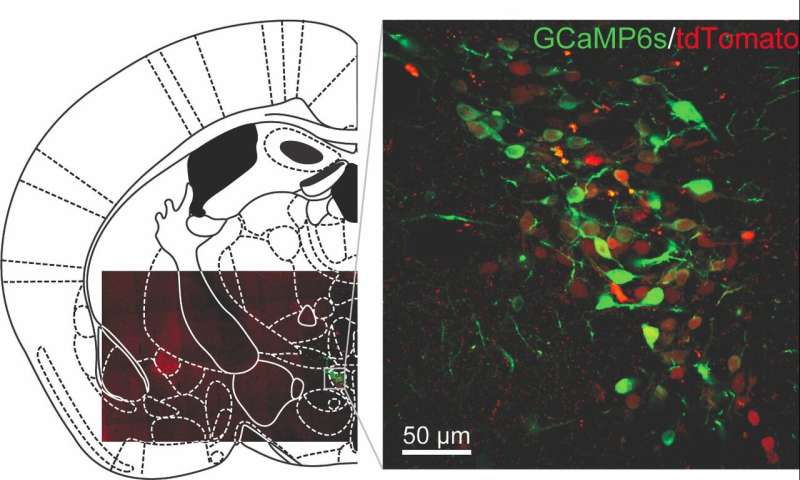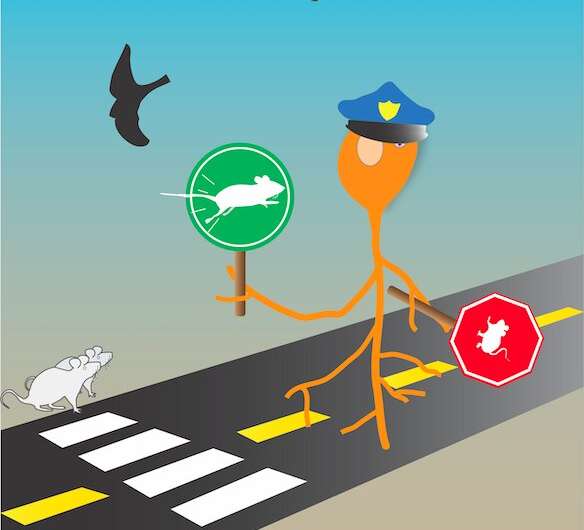March 2, 2020 feature
Exploring neural mechanisms behind the perception of control in stressful situations

Findings collected during several decades of research in the fields of psychology and neuroscience suggest that the perception of control during stressful events can have striking and long-lasting effects on the behavior of humans and some animals, including rodents. These behavioral consequences sometimes also become apparent when a person or animal is no longer in a stressful or threatening situation, resulting in uncomfortable thoughts or feelings and maladaptive behaviors.
Countless past studies have investigated the links behind perceptions during stressful situations and the rise of unhelpful mental or behavioral patterns. However, the exact biological mechanisms through which stressful experiences are linked to subsequent behavioral responses are still poorly understood.
Researchers at the University of Calgary in Canada have recently tried to shed some light on how the brains of rodents, and potentially also of humans, encode stress controllability and regulate the selection of defensive and 'fight or flight'-type behaviors. Their findings, published in Nature Neuroscience, could reveal brain areas involved in the development of trauma-related and severe anxiety disorders, which could in turn lead to the development of more effective treatment strategies.
"Starting from work in rodent models in the 1960s and extending to work on humans, there is now compelling evidence that the impact of stress on subsequent behavior and the development of PTSD-like pathologies is strongly impacted by the perception of control during the stressful event, yet how the brain accomplishes this contextual transfer remains unclear," Jaideep Bains, one of the researchers who carried out the study, told Medical Xpress. "Additionally, the broad applicability of the findings in rodent models is limited by the fact that most work in this field has assessed conditioned responses and rarely linked stress controllability to innate, unlearned behaviors."
Many past studies investigating the links between stressful events and the development of maladaptive behaviors have been carried out on rodents using conditioning techniques, thus monitoring automatic responses to stimuli acquired after experimenters consistently intervened in their environment. The findings gathered in these works may thus not be entirely applicable to humans, who are rarely systematically trained to change their behavior over time, and typically perform innate or unscripted behaviors.
In their study, Bains and his colleagues set out to explore the biological links between stress controllability and subsequent innate/unscripted behavior, which may be more similar to that observed in some humans after traumatic experiences. While they conducted their experiments on rodents, the methods they employed were hence somewhat different from those used by other researchers in the past.

"We used an ethologically relevant task: a shadow that appears in the sky and then expands in size to mimic an advancing predator," Bains explained. "Rodents execute distinct defensive behaviors not necessarily when they detect a threat, but when the imminence of the threat increases. Using genetically expressed fluorescent calcium indicator in one specific population of neurons (CRH cells in the hypothalamus), combined with fiber photometry, we could detect changes in neural activity in mice during this task."
The researchers decided to focus their investigation on CRH cells, which are known to control the secretion of hormones in the blood when responding to stress. Recent findings suggest that these cells could also be involved in different stress and stress-coping behaviors.
The experiments carried out by Bains and his colleagues yielded a number of interesting results. The researchers found that the activation of CRH neurons in the hypothalamus often predicts an active 'escape behavior'. This is a surprising observation, as this class of neurons has so far never been implicated in the selection of defensive behaviors, neither in humans nor rodents.
Interestingly, the researchers also observed that when a rodent was in a stressful situation but had substantial control over its outcome, CRH cells were activated, and subsequently, the animal tried to escape the situation. If the rodent had little control, however, CRH cells were not activated and the animal remained where it was. These observations could mean that CRH cells play a part in the selection of defensive behavior strategies, contributing to shifts between more active (e.g., escape) and passive (e.g., freeze) strategies.
"We think that CRH cells in the hypothalamus may coordinate physiological responses (i.e., heart rate, blood pressure) with defensive behavior," Bains said. "We also observed that exposure to stressful situations in the absence or presence of control changes the activity of these neurons. These changes appear to be important in modifying innate defensive behaviors."
The recent study carried out by Bains and his colleagues offers new interesting insight about the neural mechanisms that may link stressful situations to maladaptive coping strategies or mental disorders. More specifically, it suggests that CRH neurons in the hypothalamus could play a key role in how rodents and humans encode stress controllability and how they select defensive behaviors. In the future, the findings collected by this team of researchers could inspire further studies focusing on CRH cells, potentially leading to discoveries about their role in regulating coping strategies during or after stressful situations.
"We are now interested in conducting experiments that will allow us to obtain information about the activity of specific CRH cells in the hypothalamus," Bains said. "The idea here is to determine whether there are individual cells that are purposed for particular behaviors, and if so, if they project to particular brain regions. Another direction for future research will be to investigate how information about prior stress is relayed to the hypothalamus."
More information: Núria Daviu et al. Paraventricular nucleus CRH neurons encode stress controllability and regulate defensive behavior selection, Nature Neuroscience (2020). DOI: 10.1038/s41593-020-0591-0
© 2020 Science X Network

















